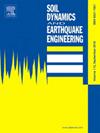Performance of dry sandy soil at free field conditions pre-and post-seismic events
IF 4.2
2区 工程技术
Q1 ENGINEERING, GEOLOGICAL
引用次数: 0
Abstract
The bearing capacities of soils and the corresponding settlements are crucial for designing safe and economical structures, but limited research assessed the varieties in the bearing capacities of the soils after an earthquake, despite several studies focusing on sandy soil settlements. This study investigated pre- and post-earthquake bearing capacities and settlements of loose and dense dry sandy soil using laboratory model loading tests and shaking table tests in three stages: first, static loading tests were conducted on strip footings; second, identical models were subjected to sinusoidal waves and real earthquake records on a shaking table under conditions simulating free-field conditions; and finally, samples exposed to seismic motions were retested under static loading to evaluate the effects of peak ground acceleration (PGA), frequency (f), duration (T), Arias Intensity (Ia) on soil response. Results revealed that PGA higher than 0.3 g significantly densified loose sand with post-seismic bearing capacity of the footing increasing up to 0.5 g before stabilizing. Higher f led to pronounced post-seismic soil performance while durations beyond 12 s had minimal impact, implying limits for further densification. Real earthquake records caused moderate volumetric strains and smaller post-seismic bearing capacity increases compared to sinusoidal waves. Initial relative density affected the volumetric strain, with loose sand reaching up to 8 % and dense sand limiting it to 2 %. Amplification was more pronounced in loose soils, increasing with rising PGA and f while slightly reduced by longer durations. These findings provide an understanding of sandy soils under seismic compression and offer a basis for post-seismic bearing capacity predictions.
干砂土在自由场条件下的震前和震后性能
土的承载力及其沉降对于设计安全经济的结构是至关重要的,但对地震后土的承载力变化进行评估的研究有限,尽管有一些研究集中在沙土沉降上。本文采用室内模型加载试验和振动台试验,分三个阶段对松散和致密干沙土的震前和震后承载力及沉降进行了研究:一是在条形基础上进行静力加载试验;其次,在模拟自由场条件下,在振动台上对同一模型进行正弦波和真实地震记录的试验;最后,在静荷载作用下对受地震运动影响的样品进行复测,评估峰值地面加速度(PGA)、频率(f)、持续时间(T)、Arias强度(Ia)对土壤响应的影响。结果表明:PGA大于0.3 g显著致密化松散砂,震后基础承载力增大至0.5 g后趋于稳定;时间越长,地震后土体表现越明显,而持续时间超过12 s的影响最小,这意味着进一步致密化的限制。与正弦波相比,真实地震记录引起的体积应变适中,震后承载力增加较小。初始相对密度影响体积应变,松散砂可达8%,而致密砂将其限制在2%。放大效应在松散土壤中更为明显,随着PGA和f的增加而增加,而随着持续时间的延长而略有降低。这些发现有助于理解地震压缩作用下的砂质土,并为震后承载力预测提供依据。
本文章由计算机程序翻译,如有差异,请以英文原文为准。
求助全文
约1分钟内获得全文
求助全文
来源期刊

Soil Dynamics and Earthquake Engineering
工程技术-地球科学综合
CiteScore
7.50
自引率
15.00%
发文量
446
审稿时长
8 months
期刊介绍:
The journal aims to encourage and enhance the role of mechanics and other disciplines as they relate to earthquake engineering by providing opportunities for the publication of the work of applied mathematicians, engineers and other applied scientists involved in solving problems closely related to the field of earthquake engineering and geotechnical earthquake engineering.
Emphasis is placed on new concepts and techniques, but case histories will also be published if they enhance the presentation and understanding of new technical concepts.
 求助内容:
求助内容: 应助结果提醒方式:
应助结果提醒方式:


